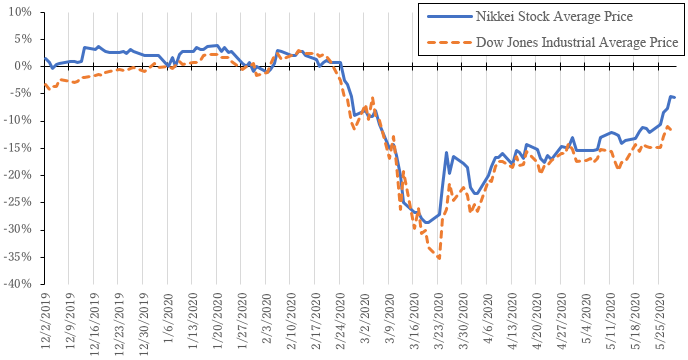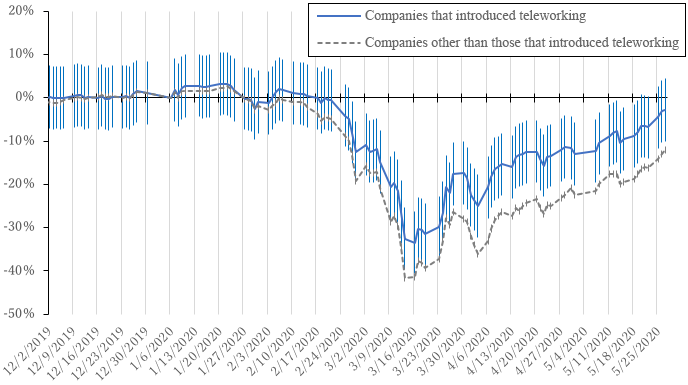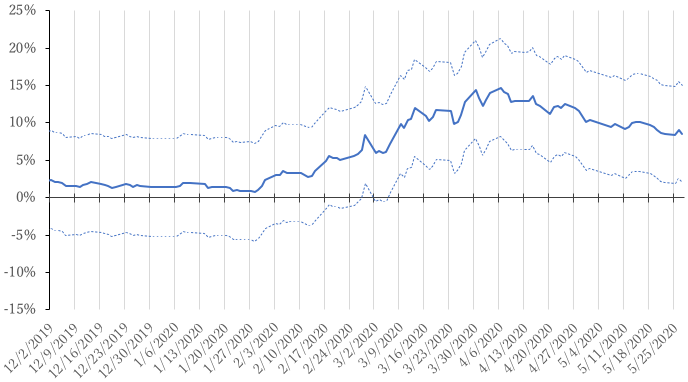Economic activities are facing a variety of restrictions and impacts associated with the spread of the novel coronavirus (Covid-19) infection and the measures to prevent its further spread. In this study, I present the results of an analysis related to the corporate value of companies that have introduced teleworking during the coronavirus crisis. The results of this analysis show that the stock prices of Japanese companies have fallen sharply during this crisis, which went into full swing at the end of February 2020. However, the stock prices of companies that are presented as teleworking case studies on the "Teleworking Information Site" of the Ministry of Internal Affairs and Communications have declined about 10% less than those of other companies. This result suggests that the stock market may expect companies that have introduced teleworking to experience relatively low impacts due to the coronavirus crisis.
Stock price changes during the coronavirus crisis
Figure 1 shows the Nikkei Stock Average and the Dow Jones Industrial Average from December 2019 to May 2020. Despite the start of the lockdown to prevent the spread of infection in Wuhan, China, in late January 2020 and the WHO's declaration of an international emergency, both the Nikkei Stock Average and the Dow Jones Industrial Average remained strong until mid-February; however, both dropped by more than 30% from late February to mid-March.

In Japan, the Expert Committee for Countermeasures Against the Novel Coronavirus Infectious Disease published its first opinion on February 24th, and on February 25th, the government's headquarters for countermeasures decided and announced the "Basic Policy on Countermeasures Against Novel Coronavirus Infectious Disease." On February 27th, Prime Minister Abe announced the temporary closure of elementary, junior high, and high schools across the country, and on February 28th, the Governor of Hokkaido made an emergency declaration for the prefecture. Then, in March, infections spread in many cities in Western countries, and lockdowns were implemented. As the infection spread to a global scale, including in Europe and the United States, the one-year postponement of the Tokyo Olympic and Paralympic Games was announced on March 24th, and, at the same time, the Governor of Tokyo, Yuriko Koike, publicly mentioned the possibility of a lockdown. The possible lockdown became a topic for discussion, increasing social unrest to an extreme level. After that, stock prices recovered from April to May and, by June, had returned to levels close to those in mid-February, before they had first begun to fall.
Efforts to introduce teleworking and corporate value during the coronavirus crisis
The Japanese stock market therefore seems to have been sensitive to the spread of the novel coronavirus infection and the government's actions since late February. However, the impact of the coronavirus crisis is likely to vary from company to company. For example, the crisis will have both short-term and medium- to long-term impacts on the demand structure, and these impacts may differ by industry. In addition, it may be easy for some industries to switch to teleworking and difficult for others. Furthermore, even within an industry, companies' efforts to introduce ICT and teleworking may differ. The stock market can be considered to reflect the effects of this heterogeneity across companies and evaluate the impact of the coronavirus crisis on corporate value.
Thus, it is useful to ask which company efforts were positively evaluated by the stock market. Here, I focus on the effects of recent efforts to introduce teleworking on the stock market's evaluation of corporate value during the coronavirus crisis.
As mentioned above, the government's Basic Policy on Countermeasures Against The Novel Coronavirus Infectious Disease announced on February 25th clearly states that "companies (abbreviated) are strongly encouraged to promote teleworking and staggered working hours." In this way, while infectious disease experts in the government, mass media, and so forth were calling for self‐imposed isolation to prevent the spread of the infectious disease except when going out was necessary, companies were strongly advised to introduce and utilize teleworking.
Furthermore, teleworking had been attracting attention in the context of the so-called "work style reforms" even before the novel coronavirus emerged. The government had especially been promoting the spread of teleworking in recent years with the aim of alleviating traffic congestion and the commuting rush during the scheduled 2020 Tokyo Olympic Games.
Since around 2012, the Japanese government, led by the Ministry of Internal Affairs and Communications and the Ministry of Health, Labour, and Welfare, has been conducting projects to widely collect and publish case studies of Japanese companies' use of teleworking and has been publicly recognizing companies that have made pioneering efforts. In addition, since 2017, these ministries have been operating the "Teleworking Information Site," which compiles the collected teleworking case studies and makes them searchable (Note 1). This website allows users to search the cases of about 300 companies that introduced teleworking (as of June 2020) collected by the Ministry of Internal Affairs and Communications and the Ministry of Health, Labour, and Welfare and browse them by region, purpose of introduction, keywords, and company size. The latest information comes from the 2017 "Cases of the Minister of Internal Affairs and Communications Award 100 Teleworking Pioneers" by the Ministry of Internal Affairs and Communications and the 2017 "Success Cases of Teleworking Utilization" and "Cases of The Shining Teleworking Award" by the Ministry of Health, Labour, and Welfare, and it is possible that there have been no updates in the past few years.
Teleworking introduction status of listed companies and changes in stock prices
I identify the companies have been registered in the "Teleworking Information Site" as successful cases of teleworking introduction and, by comparing changes in stock prices, I examine how the stock market's evaluations of companies that introduced teleworking before the coronavirus crisis differed from its evaluations of other companies. The stock price data used in the analysis were obtained by using Stooq's (https://stooq.com/) application programming interface to obtain the daily closing prices (adjusted for the impact of stock splits) of listed companies that appear on EDINET (https://disclosure.edinet-fsa.go.jp/) from December 2019 to May 2020. Stock price data were available for 3,621 of these listed companies, 35 of which were found to be companies listed on the "Teleworking Information Site" (Note 2).
Next, I investigate the characteristics of the stock prices of companies that introduced teleworking during the coronavirus crisis compared to those of other companies. Below, I describe the results of the analysis using the data set constructed via the above procedure. As mentioned above, because the "Teleworking Information Site" does not contain information from 2018, the companies that introduced teleworking in this analysis are those that were certified by the Ministry of Internal Affairs and Communications or the Ministry of Health, Labour, and Welfare as having introduced teleworking before 2017. Thus, companies that have recently begun to introduce teleworking are not included.
First, Figure 2 compares the changes in the stock prices of companies that introduced teleworking from December 2019 to May 2020 to those of other companies. These results were obtained by converting the daily stock price of each company into an index (as a percentage) based on the closing stock price as of January 6, 2020, dividing the sample into companies that introduced teleworking and other companies, and then taking the daily averages of each group. The vertical bars represent 95% confidence intervals (Note 3).

According to Figure 2, the stock prices of companies that introduced teleworking and other companies experienced almost no changes from December 2019 to late January before the coronavirus crisis, but both dropped sharply from late February to mid-March. However, a closer look at the declines in the stock price indexes as of mid-March shows that the stock prices of companies that introduced teleworking dropped about 30% on average since January 6th, whereas the stock prices of other companies dropped about 40% over the same period. Thus, companies that introduced teleworking experienced smaller declines in stock prices during the coronavirus crisis by about 10 percentage points relative to other companies. Furthermore, a closer look also shows that the stock price index of companies that introduced teleworking gradually began to differ from that of other companies in the beginning of February (however, this difference is not statistically significant). Furthermore, even after stock prices began to recover at the end of March, a difference of around 10 percentage points has continued. For example, in late May, the average stock price index of companies that introduced teleworking had recovered to approximately 3% lower than the level before the coronavirus crisis, but the average stock price index of other companies remained over 10% lower than the level before the crisis.
Differences in the introduction of teleworking may have affected corporate value during the coronavirus crisis
The above results show that companies that introduced teleworking may have received higher evaluations by the stock market during the coronavirus crisis. However, the results in Figure 2 are simply a comparison of the averages and do not control for the effects of industries and regions, making it difficult to prove that they provide evidence that the stock market really valued the introduction of teleworking. The introduction of teleworking varies greatly by industry. Thus, the results in Figure 2 may reflect industry differences rather than differences caused by the introduction of teleworking. In addition, the impact of the coronavirus crisis differs greatly across regions. The number of infected people varies from region to region, and the degree of self-restraint requested by each administration also varies. If the introduction of teleworking is concentrated in areas with lower impacts of the coronavirus crisis, the results in Figure 2 may represent regional differences in the effect of the coronavirus crisis. Thus, to address these issues, I use a difference-in-differences analysis to control for the effects of industries and regions and statistically estimate the differences in the stock prices (stock price premium) of companies that introduced teleworking and other companies (Note 4).
Figure 3 shows the estimated stock price premium for companies that introduced teleworking. There was almost no change in the stock price premium for companies that introduced teleworking until late January, but the premium gradually increased from the end of January, and the difference became statistically significant in March. From late March to early April, the expected stock price premium for companies that introduced teleworking was around 15%; although the premium decreased thereafter, a difference of around 10% still remained in late May.

Implications and remaining issues
As described above, the results of this analysis show that the stock prices of Japanese companies have fallen sharply during the coronavirus crisis, which went into full swing at the end of February 2020. However, the decrease was about 10 percentage points smaller for companies that introduced teleworking in the past relative to those that did not. This result suggests that companies that introduced teleworking in advance may have suffered less damage due to the coronavirus crisis.
However, the analysis in this study may have overestimated or underestimated the effects of introducing teleworking. Overestimation is possible because companies with financial resources or high productivity tend to introduce teleworking, and the effects of so-called confounding factors, such as financial stability and productivity, may be included in the estimated stock price premium from introducing teleworking. A methodology for future research is to control for confounding factors that are independent of the introduction of teleworking and perform a more precise statistical analysis.
Conversely, this analysis may have underestimated the effect of introducing teleworking. In this study, companies that introduced teleworking are defined only by whether they are included in the teleworking introduction cases presented on the "Teleworking Information Site." However, a number of other listed companies that do not appear among the case studies on the "Teleworking Information Site" may have introduced teleworking. The data for this study, only included the 35 listed companies that appear as case studies on the "Teleworking Information Site," which is less than 1% of all listed companies. However, it is unlikely that 99% or more of the remaining listed companies have not made efforts to introduce teleworking. One potential reason for discrepancy is that companies that have introduced teleworking in the last two years are excluded from the analysis because the "Teleworking Information Site" has not been updated in the last two years. Thus, a remaining task for future research is to collect data on companies that have introduced teleworking recently and reflect them in the analysis. Furthermore, it is necessary to build a more comprehensive database of efforts to introduce teleworking and confirm its robustness. It seems possible to more comprehensively determine the statuses of companies' efforts to introduce teleworking by utilizing other data sources, such as the information in securities reports and press releases.
In addition, the target of this analysis was to determine the effect of introducing teleworking before the start of the coronavirus crisis. Even companies that had not introduced teleworking in the past probably introduced teleworking quickly during the coronavirus crisis, and the stock market likely evaluates corporate value by including such measures taken during the coronavirus crisis. Thus, it is possible that the estimated effect of introducing teleworking may be larger when considering the effect of teleworking introduced during the coronavirus crisis. Furthermore, if teleworking is significantly promoted during the coronavirus crisis, it will likely affect Japanese companies' future productivity in the medium to long term. In the future, it will be possible to discover more meaningful implications by utilizing other data sources, such as press releases, and analyzing the effects of corporate efforts during the coronavirus crisis.


